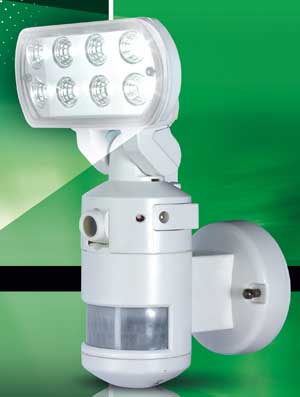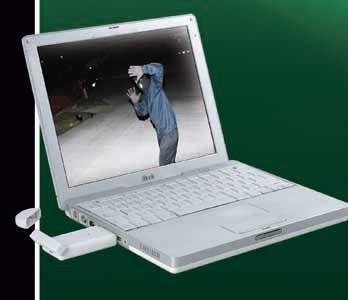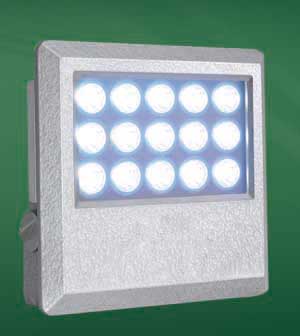Aurum Electronics Makes Home Security Smarter, Easier and Wireless
New Night Watcher has digital si
2010/04/09 | By Ken Liu | AURUM ELECTRONICS CORP.Virtually a scene out of Q’s lab in a James Bond movie, Eric Hsieh, general manager of home-security systems maker Aurum Electronics Corp., does not just talk the talk but also walks the walk: always wearing a smartphone-like gadget on his belt to show that he can watch over anytime the mansion-styled office building in Tainan, southern Taiwan. For the palm-sized controller with a 2.4-inch color, 30-megapixel TFT-LCD screen enables Hsieh to literally see, via the four corner-mounted cameras, the entire complex.
The ingenious portable video-monitor codenamed the Night Watcher ACE 9331C-SP8 has, Hsieh stresses, “many new features like digital signal and LED tracking light.”

The LED light in the Night Watcher has eight Nichia one-watt LEDs, each producing 100~120 lumens. Microprocessor-integrated and guided by three sensors aligned at three different angles, the LED light can scan a maximum of 210 degrees and up to 15 meters away.
More than mere video-monitoring, the Night Watcher’s electronic eyes capture images that are streamed via 2.4GHz to the remote controller, with the images stored in a 2GB SD disc that can then be replayed on a PC. Hsieh says that Aurum plans to upgrade to a 32GB disc to enable higher data storage in the next generation Night Watcher.
Hsieh tends to, when using the controller, shift to four-frame mode to simultaneously view via each corner-mounted camera, then simply switch to full-screen to see a clearer view through any one camera. In other words, Aurum has installed existing PC screen viewing functions as split-screen-to-full-screen and vice versa in the Night Watcher. “This is another selling point of the Night Watcher,” he notes.
Higher Level
The new Night Watcher takes the game of nocturnal, remote-controlled surveillance to a higher level by adopting wireless technology and LED, upgrading its earlier Smart Watcher line that uses wired controller and halogen lamps.
Aurum Electronics introduced wired controller 2008, changing every component but the analog transceiver and halogen lamp. Hsieh says that a British lighting magazine praised the company’s latest wireless system as the “Top Baby” during the Hong Kong International Lighting Fair last year. Aurum Electronics will display its LED-digital system at the same fair this year, scheduled for Oct. 27-30.

The company’s latest models are being marketed with ample room for personalization. Besides being pre-loaded with alarm sounds such as dog barking and human shouting, which were groundbreakers when first introduced in 1985, the new models allow, according to Hsieh, “lots of creative space for users to have fun by recording their own, preferred sounds.”
Aurum Electronics has obviously made considerable progress. The company’s first-generation surveillance systems were, stripped down as usual in the electronics business, without video-tracking capability nor were equipped with lights, as well as being prerecorded with only barking sounds.
Fortuity a Factor
The company’s road to success has not been a business school textbook example of post-graduate expert turning esoteric know-how into mankind-improving invention. The fact is that fortuity played a significant role. Aurum Electronics entered into sensor-manufacturing five years after its establishment in 1980 to make precision plastic parts for radios. Initially, the company supplied two categories of senor-activated items—lighting and alarms. “Only a handful of makers in Taiwan could supply multi-functional sensor-activated items. So we depended on Japanese suppliers for key components like control chips and controllers,” Hsieh recalls.
The company’s fate turned for the better when an American importer came to Taiwan to look for contract suppliers. The American, according to Hsieh, was sold on Aurum for its excellent precision-parts manufacturing. “He particularly appreciated the precision of our injected and die-cast parts,” Hsieh says, also crediting his father’s business of making precision parts for bicycles that helped him to learn tooling.
In few years, the company began building senor-activated lighting and alarms. In 1990, Aurum Electronics further upgraded the intelligence quotient, by using advanced microchip technologies, of sensor-activated systems by installing photo-sensitive dimming and time programmable controls. “Using microchips allows us to enhance functionality of sensor-activated items,” Hsieh stresses.
Making sensor-activated alarms may raise the technological bar higher, but the more challenging business also promises fatter profit. “The most challenging part is having to integrate electronic components with micro-motors as part of the mechanical structure,” he explains. But persistence in building thoughtful designs has paid off: Aurum is now pricing products above US$100, a huge improvement from US$30 and the humble US$20 initially.

Aurum Electronics now ships annually a million units of home security systems, up markedly from 10,000 units, most of which go to North America, Europe and Japan.
Higher R&D Expenditure
More respectable sales notwithstanding, building multi-functional surveillance systems also saddle the company with higher R&D expenditure: The AEC 9331C-SP8, for instance, cost around US$1 million to develop. “We have eight electronics specialists and 16 mechanical experts, all college graduates, working on new product development,” Hsieh says.
The R&D team has won at least 20 patents, including one for an LED lamp featuring the reflector design borrowed from auto lamp. “The reflector replaces optical lens to diffuse light angle to minimize glare,” Hsieh says. Also, some awards underscoring brilliant work such as the Sliver Award of Industrial Electronics (Parts & Components) from the 11th Hong Kong Electronics Industries Association (HKEIA) have gone to the company’s products like 9331BSD system.
According to Hsieh, LEDs have replaced halogen lamps as the major light source in most of its home-security systems and lighting fixtures, mainly due to the excessive heat produced by halogen lamps that damage precision parts and fragile microchips.
Using LEDs, which are cooler than halogens, has enabled the company to win safety approvals, including CSA, CE, RoHS directive, UL, FCC and R&TTE directive.
Revealing the company’s strength in building home-security systems, Hsieh says: “Persistent innovation, quality, reasonable pricing, and valuable functions. Above all, we’re protected by intellectual properties in competing against the Europeans and Americans.”
Protecting your home starts at Aurum
Aurum Electronics owes its pricing edge partly to moving to mainland China. “We moved only part of production to China in 1992 at the request of our American and Canadian buyers, who had become very price conscious. By 1996, we were fully producing in China, though some 80% of our R&D workforce remain in Taiwan,” Hsieh stresses.
Refusing to be complacent, Aurum’s R&D engineers are working on technologies to enable Net-enabled, video monitoring on mobile phone of homes by owners. “We aim to be the best in the home security segment by adopting, developing every piece of user-friendly technology to enhance added-value,” Hsieh says.
Also showing its tenacity to stay afloat amid the harshest recession in recent memory, the general manager has kept a stiff upper lip as business has recovered: “We have seen orders increase since the second quarter this year and some retailers tell us rising unemployment in some markets has driven more consumers to buy home-security systems,” he says.

AURUM ELECTRONICS CORP.
No. 160, Dayong Rd., Yungkang City, Tainan Hsien 710, Taiwan
Tel:+886-6-272-0116~9
Fax:+886-6-271-1890
http://www.aurum.com.tw
E-mail:[email protected]

